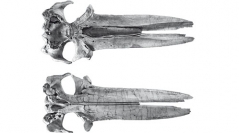

 Geodiversitas
28 (2) - Pages 319-395
Geodiversitas
28 (2) - Pages 319-395Piscobalaena nana Pilleri & Siber, 1989 is a small fossil baleen-bearing mysticete from the early Pliocene of the Pisco Formation, Peru. The holotype of this species is an incomplete skull (lacking the vertex) with associated tympanics. The description of five remarkably preserved new specimens of this taxon (three of them associated with partial post-cranial skeletons) provides the opportunity to understand the intraspecific variation within one single fossil mysticete species. These specimens constitute a partial ontogenetic series including one sub-adult animal, three adults and one old individual. Piscobalaena nana is compared to Nannocetus eremus Kellogg, 1929, Cetotherium rathkei Brandt, 1843, Herpetocetus sendaicus (Hatai, Hayasaka & Masuda, 1963) and Metopocetus durinasus Cope, 1896, which are similar in morphology and age to the Peruvian species. A parsimony analysis of 101 morphological characters of the skull, auditory area and dentary tested on 23 taxa confirms the paraphyly of the Cetotheriidae as traditionally defined. It also suggests that six (Piscobalaena, Herpetocetus, Metopocetus, Cetotherium, Nannocetus, Mixocetus) of the 12 studied fossil baleen mysticetes constitute a clade: the Cetotheriidae s.s. Its monophyly is supported by 10 characters of the skull (e.g., ascending processes of the maxillae contacting medially or very approximated at apex; lateral edges of nasals strongly convergent posteriorly; supraorbital process of the frontal anteriorly oriented), and five characters of the auditory area (e.g., anterior edge of facial foramen on the internal acoustic meatus is notched [slightly to deeply] for the passage of the greater petrosal nerve). The Cetotheriidae share with the Balaenopteridae the presence of an interdigitation of the rostral and cranial bones such as the posteriorly elongated ascending process of the maxilla. This condition reinforces the cranial architecture and could suggest a similar engulfment way of feeding as observed in the Balaenopteridae.
Mammalia, Cetacea, Mysticeti, Cetotheriidae, Piscobalaena nana, early Pliocene, Peru, anatomy